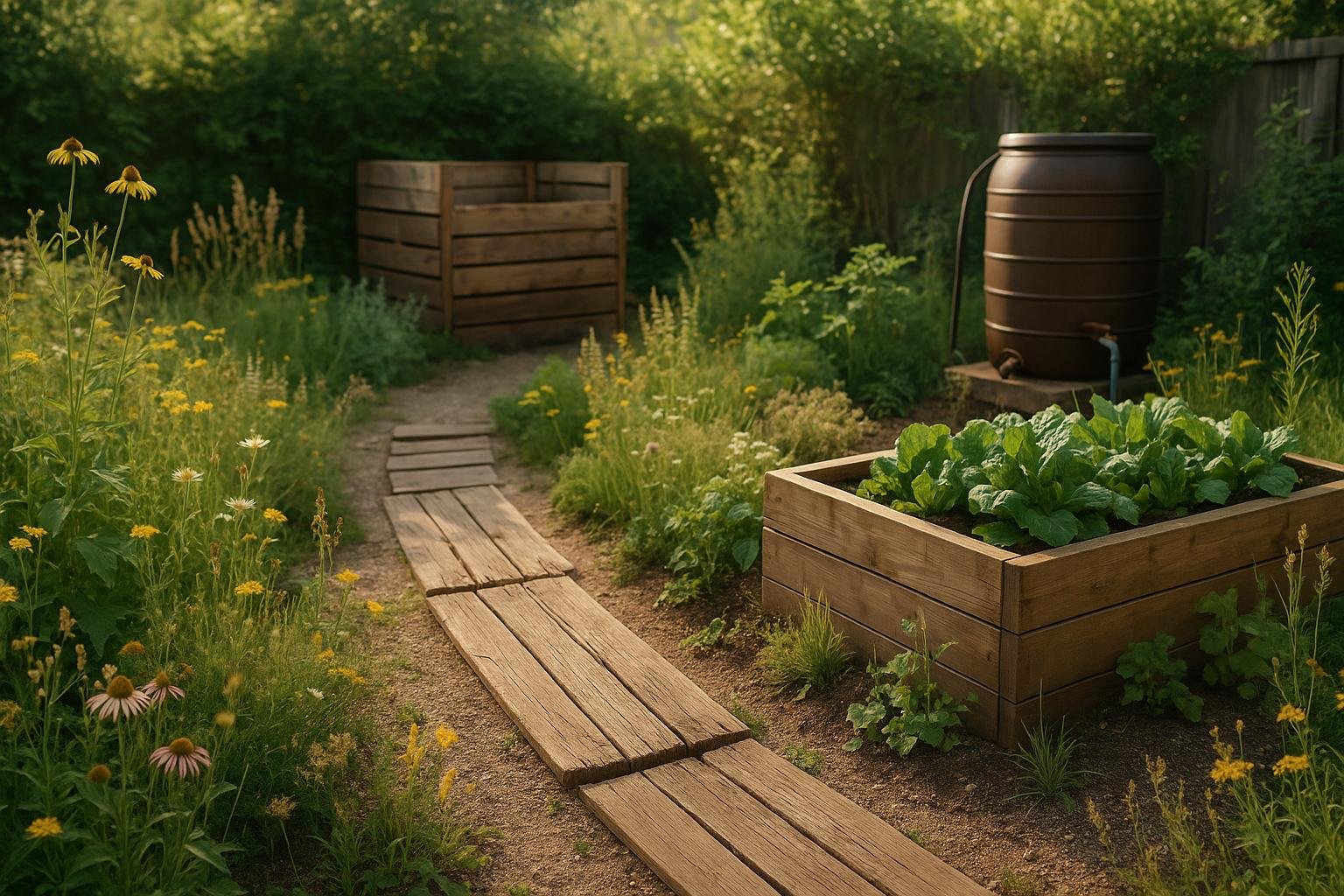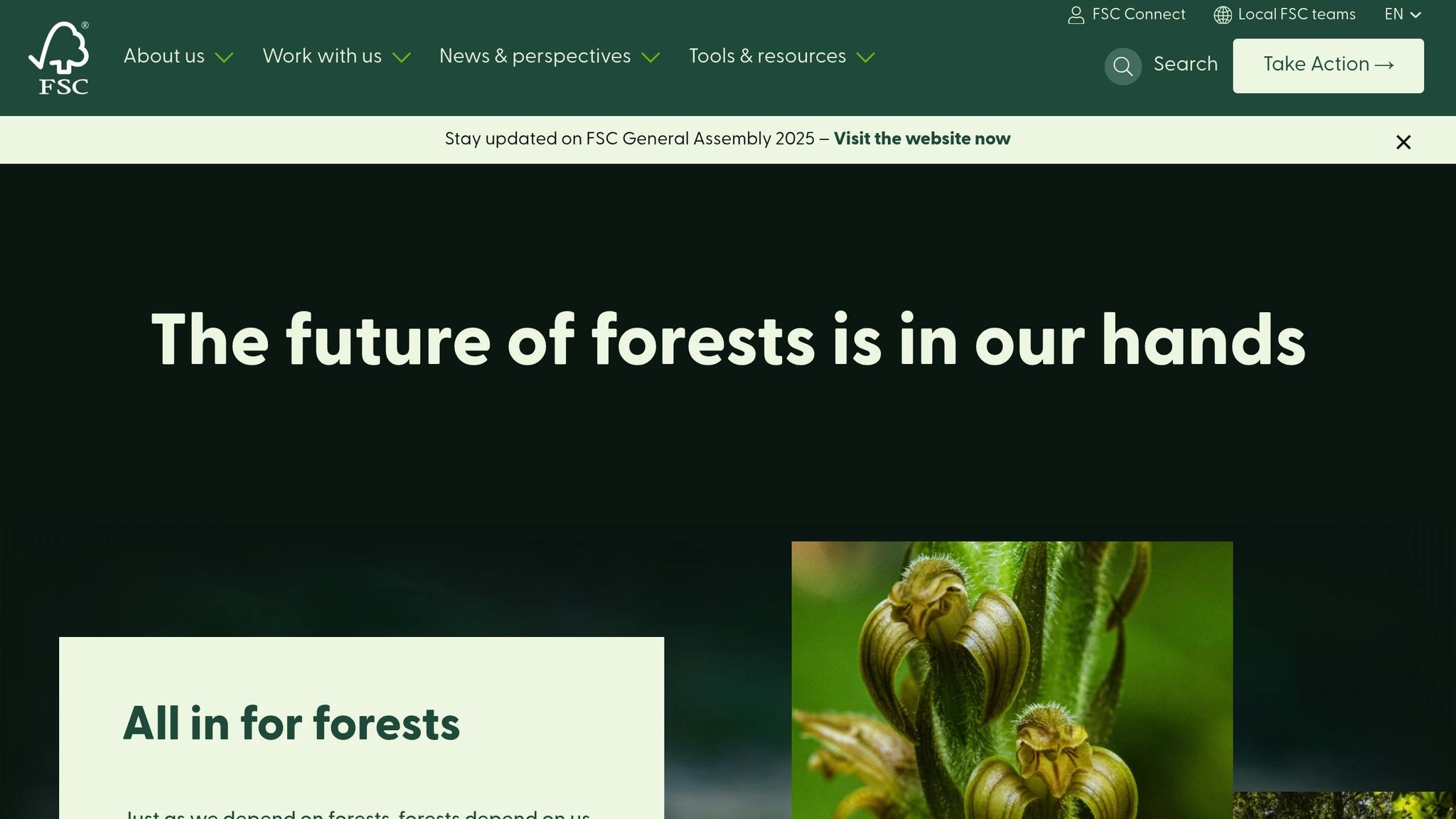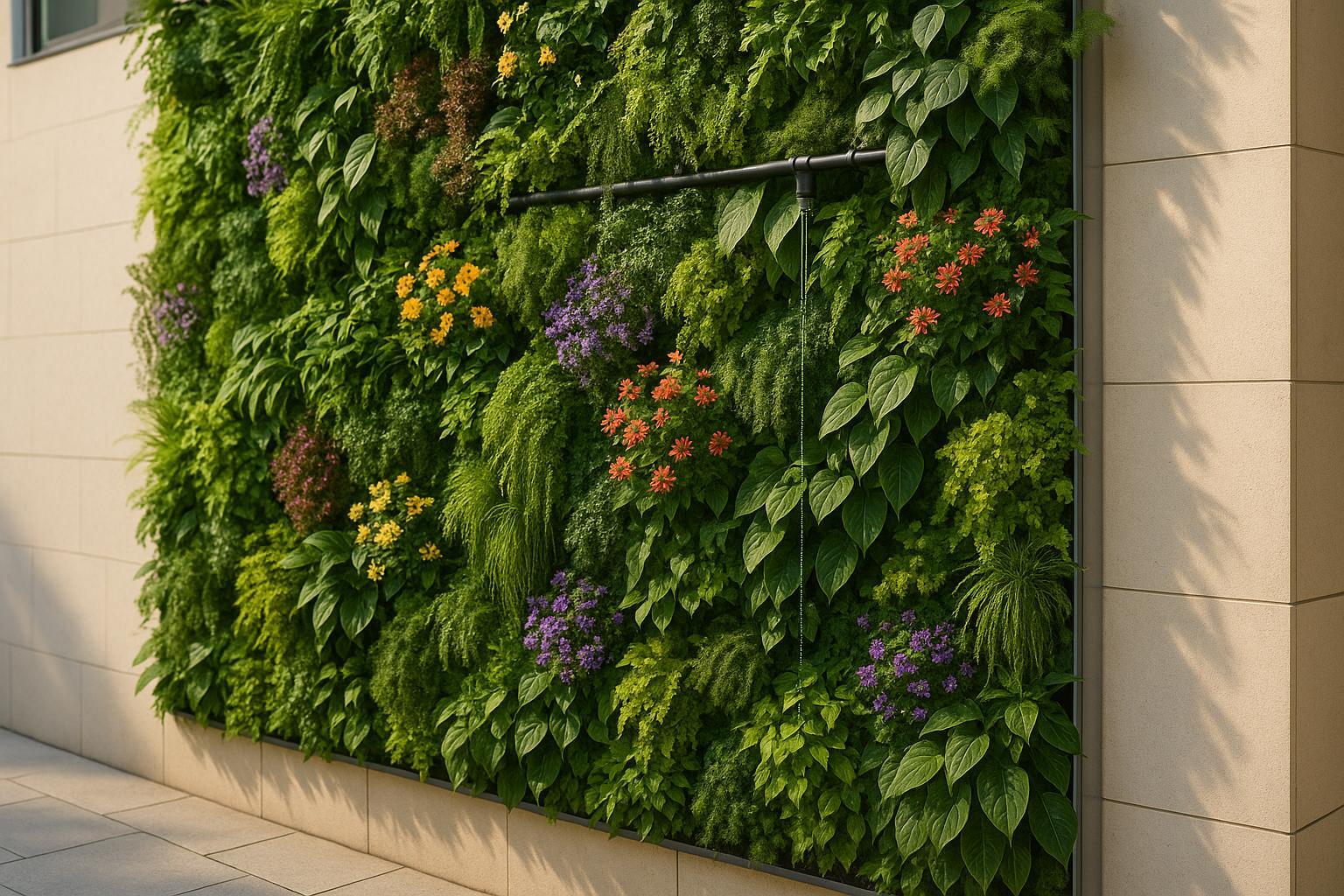Ultimate Guide to Low-Carbon Garden Materials

Want to create a low-carbon garden? Start by choosing the right materials. Low-carbon garden materials reduce greenhouse gas emissions and help fight climate change. Here's what you need to know:
- What are low-carbon materials? These are materials with minimal carbon emissions during production, processing, and transport. Examples include reclaimed wood, local stone, and FSC-certified lumber.
- Why choose them? They lower your garden's carbon footprint, support biodiversity, and reduce energy use in manufacturing and transport.
- Best materials to use:
- Reclaimed or recycled materials: Old wood, bricks, and glass reduce waste and add character.
- FSC-certified wood: Sustainably sourced wood for fences, decks, and furniture.
- Local stone: Cuts transportation emissions and works well for pathways, patios, and walls.
- Plants as a solution: Trees and plants actively absorb CO₂, replace hardscaping, and enhance your garden’s sustainability.
Quick Tip: Source materials locally, reuse what you already have, and prioritize plants over hardscaping for a greener garden. Keep reading to learn how to design and source materials for a low-carbon garden.
Types of Low-Carbon Garden Materials
If you're looking to make your garden more eco-friendly and reduce waste, consider using materials from three main categories: reclaimed or recycled materials, FSC-certified wood, and local stone. These options not only lower your carbon footprint but also add unique character to your outdoor space.
Reclaimed and Recycled Materials
Reclaimed and recycled materials are an excellent way to add charm to your garden while cutting down on landfill waste. For example, reclaimed wood is perfect for building raised beds, pathways, and other structures. Old-growth reclaimed lumber is especially durable, but steer clear of pressure-treated or contaminated pieces if you're working in areas where you'll grow food.
Recycled bricks and pavers are another cost-effective choice that delivers both function and style. A community park in Brooklyn offers a great example: nearly 80% of its materials were reclaimed, including bricks from an old industrial site for walkways and seating, and wood from shipping crates for picnic tables and pergolas. Landscape designer Dennis Pappas captures the essence of this approach:
"When we design with repurposed materials, we honor the past while building a more sustainable future."
Recycled glass is another creative option, often used for decorative accents and mosaics. Plus, recycling just one ton of glass saves an equivalent amount of raw materials and prevents nearly 700 pounds of CO₂ emissions. For a practical touch, recycled rubber mulch can help control weeds in both flower and vegetable gardens.
Before diving into reclaimed materials, take stock of what you already have on hand. Consult with a landscaper to evaluate their suitability and draft a solid plan. Treating and sealing these materials can also extend their lifespan, ensuring they remain a part of your garden for years to come.
FSC-Certified Wood

If you're considering wood for your garden, FSC-certified lumber is a responsible choice. The Forest Stewardship Council ensures that this wood comes from forests that are managed sustainably, protecting wildlife and maintaining ecological balance. In the U.S. and Canada alone, the FSC oversees 154.7 million acres of forested land. Since forests cover over 30% of the planet's land area and are home to up to 70% of terrestrial species, choosing FSC-certified wood helps preserve these critical ecosystems.
While FSC-certified wood may cost up to 15% more than non-certified options, the environmental benefits are worth it. As Gardenhouse24 puts it:
"The FSC certificate enables you to buy wooden products with a clear conscience. You can be sure that the harvested trees are replaced."
This wood is an excellent choice for fencing, decking, pergolas, raised beds, and garden furniture. FSC-certified products come in three types: FSC 100% (entirely from FSC forests), FSC Recycled (from reclaimed materials), and FSC Mix (a combination of certified and controlled sources). Look for the FSC logo when shopping, and ask contractors or vendors about their FSC options to ensure your garden aligns with sustainable practices.
Local Stone and Natural Alternatives
Local stone is another low-carbon option, especially for hardscaping projects. Because it's sourced nearby, it reduces transportation emissions and supports local businesses. Plus, these materials require minimal processing, making them one of the most eco-friendly choices for outdoor designs.
Different types of stones serve various purposes. Gravel is a versatile option for pathways, patios, and drainage, with choices like decomposed granite, river rocks, and pea gravel. Prices range from $7.95 to $92.95, depending on the quantity. For patios, steps, and fire pits, flagstone is a popular pick, with options like Arizona Flagstone at $0.34 per square foot and Autumn Slate at $0.615 per square foot. Fieldstone is another great choice for walls, fireplaces, and edging garden beds.
To get the most out of these materials, use edging made from wood, stone, concrete, or metal to keep gravel or rocks in place. Laying landscape fabric underneath can also help prevent weeds and settling. Since transportation fees can add up quickly, consider consolidating orders or picking up materials yourself to save money.
Natural stone offers additional perks: it helps prevent soil erosion, requires less water than many other hardscaping options, and is incredibly durable. It's also low-maintenance and often more affordable and easier to replace than concrete or bricks. Whenever possible, choose indigenous stones from local quarries - they offer great value and a smaller environmental impact. As Polycor explains:
"By choosing locally quarried, domestic natural stone for your projects, you can have an immensely positive impact on local economies as well."
How to Source Low-Carbon Materials
Sourcing low-carbon materials for your garden not only supports sustainability but can also lower costs. The key is knowing where to find these materials, understanding certifications that verify eco-friendly claims, and learning how to handle reclaimed materials effectively.
Finding Local Material Suppliers
Start by searching for suppliers within a 100-mile radius to cut down on transportation emissions and support nearby businesses. A quick online search for "landscaping supply near me" can help you locate regional sources for items like mulch, soil, reclaimed stone, brick, and organic fertilizers. Many local governments also run community programs offering compost or mulch, so it’s worth checking those out.
For instance, Randles Sand and Gravel in the Pacific Northwest supplies sustainable materials for both residential and commercial projects in areas like Bonney Lake and Gig Harbor. Similarly, Outdoor Warehouse Supply in Lewisville, Texas, provides bulk materials, including natural stone and pavers, with delivery options for added convenience.
Native plant nurseries are another great resource - they often stock eco-friendly landscaping solutions along with locally produced compost and mulch. Don’t forget about salvage yards and construction material resellers, which can be treasure troves for recycled and repurposed materials.
Understanding Material Certifications
Certifications are essential for distinguishing genuinely sustainable materials from those with misleading claims. For wood products, look for the FSC (Forest Stewardship Council) label. Each FSC certification comes with a unique number that you can verify directly on the FSC website. If a supplier claims FSC certification, ask for this number and confirm its validity.
Other certifications to look for include Cradle to Cradle Certified, which supports circular economy principles, and OMRI Listed, which applies to organic materials like fertilizers. Be mindful of greenwashing - both intentional and accidental - by always verifying certification numbers.
Once you’ve confirmed the authenticity of certifications, consider integrating reclaimed materials into your project for an even lower carbon footprint.
Working with Reclaimed Materials
Reclaimed materials are a fantastic way to lower emissions while adding character to your garden. As garden designer Jilayne Rickards puts it:
"This sustainable approach also reduces a garden's carbon impact, preventing items going to landfill and polluting the soil and groundwater".
To source reclaimed materials, connect with local demolition companies or visit architectural salvage yards. Compare prices and inventory at recycling centers within a 25-mile radius to minimize transportation emissions.
Before purchasing, inspect materials carefully. Check that concrete is free of contaminants and structurally sound, and ensure wood hasn’t been treated with toxic substances like creosote. If you’re using repurposed containers, make sure they allow for proper drainage.
Since reclaimed materials often come in irregular shapes and sizes, plan your design thoroughly and purchase about 10% more material than you think you’ll need to account for waste. This is especially important for projects like pathways, walls, and borders.
When installing reclaimed materials, use a sand or gravel base to ensure stability and drainage, particularly for garden paths. For untreated wood, apply non-toxic, eco-friendly finishes to prevent chemicals from leaching into the soil. Balance the hardscape elements, like reclaimed concrete, with plants and organic shapes to create a natural, harmonious look.
Benefits of Low-Carbon Garden Materials
Opting for low-carbon materials in your garden brings a mix of environmental, financial, and aesthetic advantages. These choices not only help address climate challenges but also save money and enhance the beauty of your outdoor space.
Climate and Ecosystem Benefits
Every material you select plays a role in creating a more sustainable garden. Low-carbon materials are particularly effective in addressing climate change by boosting soil carbon sequestration, a proven way to reduce carbon in the atmosphere.
Healthy soil is a key player in this process. For example, temperate woodlands and prairies can absorb roughly 1,000 pounds of carbon per acre annually. Over a decade, soil carbon levels can rise from 1–2% to as much as 5–8%, locking away a significant portion of human-generated emissions. To put that in perspective, just 1% of carbon in soil equals about 8.5 tons per acre, and over ten years, this can grow to 25–60 tons per acre.
Low-carbon materials also create habitats for wildlife and improve soil health, reducing erosion by up to 80% and even cutting noise pollution by up to 10 decibels. Examples from around the world show how impactful these changes can be. In Detroit, vacant lots have been turned into community gardens, increasing food security and cooling urban heat islands. Seattle’s rain garden program has helped manage stormwater while improving water quality. Meanwhile, pollinator-friendly garden initiatives in the UK have led to noticeable increases in pollinator populations.
Cost Savings and Budget Benefits
The benefits of low-carbon materials extend to your wallet, too. They’re often more affordable than new materials, and their durability can lead to long-term savings. Reclaimed and recycled materials, for instance, are not only cost-effective but also perform just as well - or even better - than newly produced options.
Take greenhouses as an example: building one with recycled materials can cut construction costs by 40–70%. Reclaimed materials typically cost far less than new ones, and their durability means reduced maintenance expenses over time.
Jason Hawes, a PhD candidate at the University of Michigan, highlights the importance of these early decisions:
"Whatever you put in at the very beginning often has a really long-term impact."
A great case study is the Star Garden in St. Albert, Canada. Gardeners there use free materials like discarded cardboard, wood chips, straw, and grass clippings to build garden beds, cutting both costs and environmental impact. Locally sourcing materials also helps reduce shipping expenses, and DIY greenhouses made from recycled materials can divert up to 1,000 pounds of waste from landfills while saving money.
Natural Beauty and Visual Appeal
Low-carbon materials don’t just make sense environmentally and financially - they also bring a unique charm to your garden. Reclaimed materials like weathered wood or local stone add texture and character, while telling a story of sustainability.
Salvaged pieces can create striking designs, whether it’s mosaics made from recycled glass, sculptures crafted from repurposed metals, or bold, painted concrete chunks. In Erith, London, a collaboration between Local Works Studio and Sarah Price used local clay to craft bricks for a garden at The Exchange, blending sustainability with place-specific beauty.
sbb-itb-4d6a8dd
🚀 Ready to Reinvent Your Garden?
Join thousands of homeowners who have transformed their gardens using our AI design tool. Upload one photo to explore endless possibilities.
Get your AI garden designs →Application Tips for Low-Carbon Materials
Incorporating low-carbon materials into your garden takes careful planning and smart design choices. These tips will help you use sustainable materials effectively while cutting down your garden's carbon footprint.
Creating Plant-Centered Garden Designs
The best low-carbon gardens focus on plants rather than manufactured materials. This approach not only reduces the need for materials but also enhances carbon absorption and other environmental benefits. For example, instead of building fences or walls, consider using hedges or tall perennials to create privacy and structure in your outdoor space.
Reusing existing materials can also save money and reduce waste. Working with reclaimed materials might take more time than buying new ones, but it’s worth the effort. For instance, in 2018, the U.S. produced 600 million tons of construction and demolition waste. By using reclaimed wood for raised beds, garden furniture, or decorative elements, you can help cut down on this waste. Old shipping containers can be repurposed as storage sheds or multi-tiered planting structures. Even items like discarded pallets can become vertical planters, and old tires can be stacked and filled with soil to create raised garden beds.
Next, consider how permeable surfaces can enhance your plant-focused design by improving water management and minimizing runoff.
Installing Permeable Surface Options
Permeable surfaces provide a natural way to manage stormwater while reducing your dependence on manufactured materials. These surfaces let water seep into the ground, replenishing groundwater supplies instead of causing runoff.
For walkways and patios, crushed concrete is an excellent option as aggregate. Just make sure the reclaimed concrete is clean and free of contaminants. Pair it with natural elements like plants or mulch for a cohesive look. A thick, clean layer of aggregate works well as a base for any permeable pavement application.
Products like TRUEGRID pavers can stabilize gravel surfaces, preventing rutting and spillage while maintaining permeability. These are particularly useful for driveways, allowing grass coverage while protecting the underlying surface.
In February 2025, East City homeowners Andrea Hicks and Haydn McBride installed Ecoraster's Bloxx product to tackle runoff issues from their driveway. The grid system was easy enough for the whole family to help with, making it a practical DIY project.
Recycled glass is another option worth exploring. It works as a mulch alternative, offering excellent drainage and weed control. Plus, recycling one ton of glass saves over a ton of natural resources and prevents nearly 700 pounds of carbon dioxide emissions.
Material Comparison Guide
Once you’ve chosen how to apply low-carbon methods, comparing materials can help you make the best choices for your garden. Consider factors like cost, maintenance, and water permeability to find the right fit.
| Material | Basic Cost | Maintenance Costs | Water Permeability |
|---|---|---|---|
| Asphalt | Medium | Low | Low |
| Concrete | Medium | Low | Low |
| Permeable Brick | Low | Medium | Medium |
| Grass Brick | Low | Medium | Medium |
| Planting Grid | Medium | High | High |
| Cobblestone | Low | Medium | Medium |
Concrete, in particular, poses challenges due to its environmental impact. Cement production alone accounts for 8% of global greenhouse gas emissions, and traditional concrete makes up 50–85% of the embodied carbon in construction projects. However, bio-concrete alternatives offer a promising solution. For example, bamboo bio-concrete has a carbon footprint of -113 kgCO₂-eq./m³, while wood bio-concrete comes in at -109 kgCO₂-eq./m³ for WBC 50.
When comparing construction materials, concrete blocks emit 55.3 kgCO₂-eq./m², while bio-concrete blocks like BBC50 reduce this to 37.4 kgCO₂-eq./m² - a 32% decrease.
Transportation distance also plays a big role in a material’s overall carbon footprint. Sourcing materials from local suppliers can lower emissions while also supporting your local economy. Durability and the potential for reuse or recycling are other key factors to consider. Materials with a long lifespan and the ability to be repurposed are better for long-term sustainability.
For the most eco-friendly results, focus on materials with low embodied emissions and high carbon storage potential. Whenever possible, select renewable, locally sourced options and design with durability in mind. By planning for a material’s entire lifecycle, you’ll reduce waste and create a more sustainable, low-carbon garden.
Conclusion
By adopting thoughtful strategies, your garden can become a model of sustainability. Designing a low-carbon garden starts with careful planning and choosing eco-conscious materials. Prioritizing plants over large-scale hardscaping not only reduces your garden’s carbon footprint but also enhances its ability to capture carbon. Opt for perennials and long-lived trees to create lush, low-maintenance spaces that benefit the environment.
When it comes to hardscaping, go for low-carbon alternatives like gravel or natural stone instead of concrete. Sourcing materials locally can significantly cut down on transportation emissions. You can also embrace creative reuse by incorporating reclaimed wood or compressed earth blocks for structures like retaining walls, reducing the need for traditional, energy-intensive materials.
Sustainable gardening doesn’t have to be overwhelming - start small and build over time. Simple steps like using mulch to conserve water and suppress weeds can make a big difference. Gradually, you can add features like rainwater collection systems or native plants that thrive in your local climate. With steady effort, your garden can evolve into a beautiful, low-maintenance space that also contributes to carbon sequestration.
For a more tailored approach, consider using AIGardenPlanner’s smart design tools. With location-specific plant suggestions and access to over 50 garden styles, you can design a space that supports local ecosystems while keeping environmental impact to a minimum. Your garden can be more than just a backyard - it can be a meaningful step toward climate action.
FAQs
How can I confirm if a material is genuinely low-carbon and sustainable?
To determine if a material is genuinely low-carbon and eco-friendly, start by looking for certifications from trusted organizations like LEED or Energy Star. These certifications confirm that the material meets specific environmental standards. Another valuable resource is Environmental Product Declarations (EPDs), which outline a material’s carbon footprint and its broader impact on the environment.
It’s also worth digging into the manufacturer’s practices and supply chain to gauge their dedication to environmentally conscious principles. Watch out for vague claims or greenwashing - always rely on verified, independent sources for confirmation. By following these steps, you’ll be better equipped to make thoughtful, eco-conscious decisions for your garden.
How can I find reclaimed materials to use in my garden?
How to Source Reclaimed Materials for Your Garden
Using reclaimed materials in your garden is a smart way to cut costs and reduce waste. Start by browsing local online platforms like Craigslist, Facebook Marketplace, or Nextdoor. These sites often feature free or low-cost items like leftover wood, bricks, or other materials from nearby renovation projects.
You can also check out Habitat for Humanity ReStores, which offer donated building supplies at discounted prices. Salvage yards and construction sites are other great places to find discarded items like wood or stone. If you know any local builders or contractors, it’s worth reaching out - they might have extra materials they’re willing to share or sell.
Incorporating reclaimed materials not only gives your garden a unique touch but also supports more sustainable gardening practices.
How can I combine hardscaping and plants to create a sustainable, low-carbon garden?
To create a garden with a smaller carbon footprint, it's important to strike a balance between hardscaping and greenery by using eco-friendly materials and incorporating native plants. Instead of traditional concrete, consider permeable options like gravel or decomposed granite. These materials not only allow water to seep into the ground naturally but also have a lower environmental impact compared to concrete, which is energy-intensive to produce.
Choosing native plants is another effective way to reduce your garden's carbon emissions. These plants are naturally adapted to the local climate, so they require less water, fewer resources, and minimal upkeep. To further integrate greenery into your design, think about adding planters, green walls, or planting between pavers. This not only makes your garden visually appealing but also encourages biodiversity and supports a more sustainable outdoor space.
🎨 Visualize Your Dream Garden Today!
Transform any outdoor space into a professional landscape design in minutes. Just upload a photo, choose your style, and let our AI do the rest.
Start your garden transformation now →Related posts
Related Articles

AI Scheduling for Vertical Gardens
Explore how AI scheduling enhances vertical gardening by optimizing irrigation, improving plant health, and conserving resources.

Ultimate Guide to Gardening in Arizona: Tips for Success
Discover essential tips and insights for starting and maintaining a successful garden in the unique climate of Arizona. Learn about choosing the right location, selecting the best plants, dealing with pests, and more!

How Disease Prediction Models Reduce Crop Loss
AI-driven disease prediction models help farmers reduce crop losses, optimize resource use, and improve yields through early detection and actionable insights.

Optimizing Pest Control with Data Analytics
Explore how data analytics and AI are revolutionizing pest control, improving efficiency, and protecting crops with smarter, eco-friendly solutions.

Best Free Pest Recognition Datasets Online
Explore the best free datasets for pest recognition that enhance AI tools for effective and sustainable pest management in agriculture and gardening.

How AI Adjusts Pest Control in Real Time
Explore how AI revolutionizes pest control with real-time data for precise monitoring, efficient management, and reduced environmental impact.